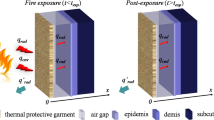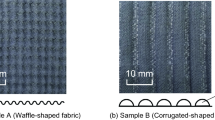Abstract
Municipal firefighters count on their protective garments to avoid skin burns caused by thermal and flame exposures. Typical firefighting garment consists of three layers of different fire-resistant fabrics named as outer shell, moisture barrier and thermal liner. This paper employed a numerical heat transfer model for firefighters’ garments, which paid more attention to modeling air gaps bounded between garment’s layers. The paper explored and compared the influences of air gaps bounded between garment’s layers on its protective performance. Specifically, the paper investigated the effect of a variation in the air gaps between the garment layers from 1 mm to 6 mm, a variation in the backside emissivity of the outer shell and moisture barrier layers from 0.9 to 0.1 and a variation in their typical thicknesses from 50% to 200% on the protective performance of garment. The results showed that increasing the width of the gap between the moisture barrier and the thermal liner, reducing the outer shell backside emissivity and increasing the moisture barrier thickness improves the protective performance of firefighters’ garments more than does increasing the width of the gap between the moisture barrier and outer shell, reducing the moisture barrier backside emissivity and increasing the outer shell thickness, respectively.









Similar content being viewed by others
Abbreviations
- c P :
-
Specific heat
- \(\hat{e}_{y}\) :
-
Unit vector in y-direction
- G :
-
Incident irradiation
- h :
-
Convection heat transfer coefficient
- I :
-
Irradiation intensity
- k :
-
Thermal conductivity
- P :
-
Pre-exponential factor
- \(q^{{\prime \prime }}\) :
-
Heat flux
- \(\overset{\lower0.5em\hbox{$\smash{\scriptscriptstyle\rightharpoonup}$}} {r}\) :
-
Position vector
- R :
-
Universal gas constant
- \(\hat{s}\) :
-
Unit vector
- T :
-
Temperature
- t :
-
Time
- y :
-
Vertical coordinate
- \(\varphi\) :
-
Azimuthal angle
- \(\kappa\) :
-
Absorption coefficient
- \(\omega\) :
-
Blood perfusion rate
- \(\rho\) :
-
Density or reflectivity
- \(\varepsilon\) :
-
Emissivity
- \(\gamma\) :
-
Extinction coefficient
- \(\theta\) :
-
Polar angle
- \(\phi\) :
-
Quantitative coefficient of skin damage
- \(\Delta E\) :
-
Skin activation energy
- \(\varOmega\) :
-
Solid angle
- \(\sigma\) :
-
Stefan-Boltzmann constant
- air :
-
Air gap
- amb :
-
Ambient surroundings
- b :
-
Black body/human blood
- cnv :
-
Heat transfer by convection
- cr :
-
Body core
- ep, ds, sc :
-
Epidermis, dermis, subcutaneous skin layers
- exp :
-
Exposure
- fab :
-
Fabric
- g :
-
Hot gases
- lin :
-
Thermal liner
- msr :
-
Moisture barrier
- R :
-
Heat transfer by radiation
- shl :
-
Outer shell
Refernces
Beyler CL (2001) Fire safety challenges in the 21st century. J Fire Prot Eng 11(1): 4–15
National Fire Protection Association (2007) NFPA 1971 standard on protective ensemble of structural firefighting. Massachusetts, USA
Mell WE, Lawson JR (2000) A heat transfer model for firefighters’ protective clothing. J Fire Technol 36: 39–68
Chitrphiromsri P (2004) Modeling of thermal performance of firefighter protective clothing during the intense heat exposure. Ph.D. Thesis, North Carolina State University, Raleigh, NC
Barker RL, Guerth-Schacher C, Grimes RV, Hamouda H (2006) Effect of moisture on the thermal performance of firefighter protective clothing in low-level radiant heat exposures. Text Res J 76(1): 27–31
Onofrei E, Petrusic S, Bedek G, Dupont D, Soulat D, Codau T (2014) Study of heat transfer through multilayer protective clothing at low-level thermal radiation. J Ind Text 45(2): 222–238
Shinohara M, Yanai E (2005) Effect of a moisture barrier on heat transfer through firefighters’ protective clothing. In: Proceedings of the 3rd international conference on human-environment system, Tokyo, Japan, pp 196–201
Song G, Chitrphiromsri P, Ding D (2008) Numerical simulation of heat and moisture transport in thermal protective clothing under flash fire conditions. Int J Occup Saf Ergon 14(1): 89–106
Jiang YY, Yanai E, Nishimura K, Zhang H, Abe N, Shinohara M, Wakatsuki K (2010) An integrated numerical simulator for thermal performance assessments of firefighters’ protective clothing. Fire Saf J 45: 314–326
Mercer GN, Sidhu HS (2007) Mathematical modeling of the effect of fire exposure on a new type of protective clothing. ANZIAM 49: C289–C305
Mercer GN, Sidhu, HS (2009) A theoretical investigation into phase change clothing benefits for firefighters under extreme conditions. Chem Prod Process Model 4: 3
Hu Y, Huang D, Qi Z, He S, Yang H, Zhang H (2013) Modeling thermal insulation of firefighting protective clothing embedded with phase change material. Heat Mass Transf 49: 567–573
Elgafy A, Mishra S (2014) A heat transfer model for incorporating carbon foam fabrics in firefighter’s garment. Heat Mass Transf 50: 545–575
Ghazy A, Bergstrom DJ (2013) Numerical simulation of fabric’s motion on protective clothing performance during flash fire exposure. Heat Mass Transf 49: 775–788
Ghazy A (2014) Numerical study of the air gap between fire-protective clothing and the skin. J Ind Text 44(2): 257–274
Ghazy A (2014) Influence of thermal shrinkage on protective clothing performance during fire exposure: numerical investigation. Mech Eng Res J 4(2): 1–15
Pennes HH (1948) Analysis of tissue and arterial blood temperatures in resting human forearm. J Appl Physiol 1: 93–122
Henriques FC Jr, Moritz AR (1947) Studies of thermal injuries I: the conduction of heat to and through skin and the temperatures attained therein. A theoretical and experimental investigation. Am J Pathol 23: 531–549
Trovi DA (2005) Effects of thermal properties on skin burn predictions in longer duration protective clothing tests. J ASTM Int 2(1): 1–13
Author information
Authors and Affiliations
Corresponding author
Additional information
Publisher's Note
Springer Nature remains neutral with regard to jurisdictional claims in published maps and institutional affiliations.
Rights and permissions
About this article
Cite this article
Ghazy, A. On the Protective Performance of Firefighters’ Garments: Air Gaps Between Fabric Layers. Fire Technol 56, 821–836 (2020). https://doi.org/10.1007/s10694-019-00905-w
Received:
Accepted:
Published:
Issue Date:
DOI: https://doi.org/10.1007/s10694-019-00905-w




